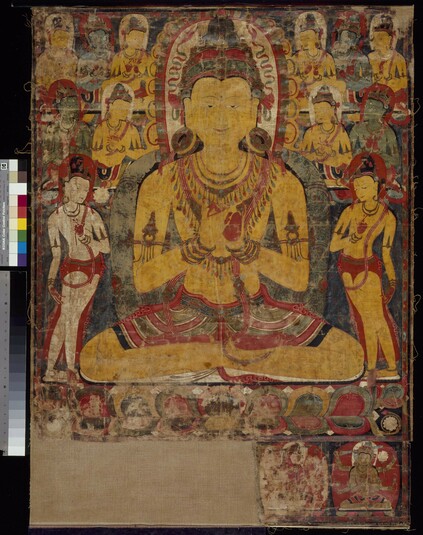
Item: Vairochana Buddha - (Sambhogakaya Ornaments)
| Origin Location | Tibet |
|---|---|
| Date Range | 1100 - 1199 |
| Lineages | Buddhist |
| Size | 100.33x73.33cm (39.50x28.87in) |
| Material | Ground Mineral Pigment on Cotton |
| Collection | Asian Art Museum of San Francisco |
| Catalogue # | 1992.58 |
Classification: Deity
Appearance: Peaceful
Gender: Male
Vairochana, Buddha (Tibetan: nang par nang dze, sang gye): a principal buddha within Vajrayana Buddhism residing in the center or eastern quarter of the mandala, and a minor buddha within the sutra tradition of Mahayana Buddhism.

"Arising in the eastern direction is Vairochana on a lion, lotus and moon throne; with a body white in colour the hands are in the mudra of supreme enlightenment." (Dragpa Gyaltsen, 1147-1216).
Peaceful and youthful in appearance, gold in colour with one face and two hands he performs the mudra of Dharma teaching at the heart. Adorned with an elaborate crown, earrings, necklaces, bracelets and the like, he wears a skirt of various colours. With the legs folded together in vajra posture atop a multi-coloured lotus supported throne, a nimbus and aureole of light surround his head and body.
At the sides stand two bodhisattvas, white on the viewers left and yellow on the right, displaying various mudras and wearing jewels and silks; standing on lotus seats. In the upper portion of the composition are ten bodhisattva figures, all seated and all wearing similar ornaments and dress as the central Vairochana Buddha. In the lower register are likely to be five deities each with three faces and six hands; seated in the cross-legged vajra posture.
Belonging to a larger set of paintings containing the buddhas of all five families, Vairochana plays a central role in Vajrayana Buddhism as Lord of the 1st of the Five Buddha Families of the higher tantras and found throughout all 4 tantra classifications most notably the yoga and anuttarayoga classes.
Jeff Watt 6-2009
Subject: Five Buddhas Main Page (Directions, Tantric, Symbolic)
Subject: Five Buddhas (Early Painting Sets)
Collection of Asian Art Museum of San Francisco
Subject: Tatagatas & Figures (Similar Characteristics)
Buddhist Deity: Vairochana Buddha Main Page
Buddhist Deity: Vairochana (Charya & Yoga Tantras)
Buddhist Deity: Vairochana, 毗卢遮那佛, རྣམ་པར་སྣང་མཛད། (Painting Masterworks)
Painting Style: Indian (11th to 13th century)
Collection of Asian Art Museum of San Francisco (Masterworks)
Collection of Asian Art Museum of San Francisco (Curator's Selection, Painting Masterworks)
